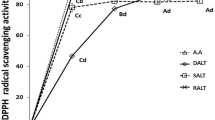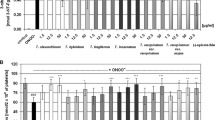Abstract
Tea (Camellia sinensis) is one of the most popularly consumed beverage worldwide. It is consumed mostly as green tea, oolong, or black tea. Black tea, good source of flavan-3-ols the theaflavins: mixture of theaflavin (TF), theaflavin-3-gallates, theaflavin-3′-gallates and theaflavin-3,3′-digallates, possess numerous biological and therapeutic properties. However, the exact mechanisms underlying these properties of TFs remain speculative. In the present study, we investigated the in vitro protective effect of theaflavin on membrane protein carbonyl group, sulfhydryl group (–SH) and erythrocyte hemolysis in rat. TFs (at micromolar concentration) showed significant antioxidant effect in protecting erythrocytes from oxidation-induced changes.


Similar content being viewed by others
References
Bandyopadhyay U, Das D, Banerjee RK (1999) Reactive oxygen species, oxidative stress and pathogenesis. Curr Sci 77:658–666
Halliwell B, Gutteridge JM (1986) Oxygen free radicals and iron in relation to biology and medicine: some problems and concepts. Arch Biochem Biophys 246:501–514
Maridonneau I, Braquet P, Garay RP (1983) Na++and K+transport damage induced by oxygen free radicals in human red cell membranes. J Biol Chem 258:3107–3117
Tsantes AE, Bonovas S, Travlou A, Sitaras NM (2006) Redox imbalance, macrocytosis, and RBC homeostasis. Antioxid Redox Signal 8:1205–1216
Khan N, Mukhtar H (2007) Tea polyphenols for health promotion. Life Sci 81:519–533
Rietveld A, Wiseman S (2003) Antioxidant effects of tea: evidence from human clinical trials. J Nutr 133(10):3285S–3292S
Weisburge JH, Fung-Lung C (2002) Mechanisms of chronic disease causation by nutritional factors and tobacco products and prevention by tea polyphenols. Food Chem Toxicol 40:1145–1154
Fatima M, Rizvi SI (2011) Health beneficial effects of black tea. Biomedicine 31(1):3–8
Marchesi VT, Palade GE (1967) The localization of Mg–Na–K-activated adenosine triphosphatase on red cell ghost membranes. J Cell Biol 35:385–404
Levine RL, Garland D, Oliver CN, Amici A, Climent I, Lenz AG, Ahn BW, Shaltiel S, Stadtman ER (1990) Determination of carbonyl content in oxidatively modified proteins. Methods Enzymol 186:464–478
Lowry OH, Rosebrough NJ, Farr AL, Randall RJ (1951) Protein measurement with the folin phenol reagent. J Biol Chem 193:265–275
Kitajima H, Yamaguchi T, Kimoto E (1990) Hemolysis of human erythrocytes under hydrostatic pressure is suppressed by cross-linking of membrane proteins. J Biochem 108(6):1057–1062
Lee MJ, Lambert JD, Prabhu et al (2004) Delivery of tea polyphenols to the oral cavity by green tea leaves and black tea extract. Cancer Detect Prev 13:132–137
Pandey KB, Rizvi SI (2010) Markers of oxidative stress in erythrocytes and plasma during aging in humans. Oxid Med Cell Longev 3:2–12
Bahorun T, Luximon-Ramma A, Gunness TK et al (2010) Black tea reduces uric acid and C-reactive protein levels in humans susceptible to cardiovascular diseases. Toxicol 278:68–74
Reglinski J, Hoey S, Smith WE, Sturrock RD (1988) Cellular response to oxidative stress at sulfihydryl group receptor sites on the erythrocyte membrane. J Biol Chem 263(12):360–366
Leung LK, Su Y, Chen R, Zhang Z, Huang Y, Chen ZY (2001) Theaflavins in black tea and catechins in green tea are equally effective antioxidants. J Nutr 13:2248–2251
Yang CS, Chen L, Lee MJ, Balentine D, Kuo MC, Schantz SP (1998) Blood and urine levels of tea catechins after ingestion of different amounts of green tea by human volunteers. Cancer Epidemiol Biomarkers Prev 7:351
Kinlen LJ, Willows AN, Guldblatt P, Yudkin J (1988) Tea consumption and cancer. Br J Cancer 58:397–401
Stocks P (1970) Cancer mortality in relation to national consumption of cigarettes, solid fuel, tea and coffee. Br J Cancer 24:215–225
Frei B, Higdon JV (2003) Antioxidant activity of tea polyphenols in vivo: evidence from animal studies. J Nutr 133(10):3275S–3284S
Acknowledgments
Mahejabeen Fatima is the recipient of UGC Research fellowship from CRET. This research work was supported by the University Grants Commission, New Delhi, through a research grant (MRP 37-292/2009 SR) to S. I. Rizvi.
Conflict of interest
The authors report no conflict of interest.
Author information
Authors and Affiliations
Corresponding author
Rights and permissions
About this article
Cite this article
Fatima, M., Rizvi, S.I. Anti Oxidative Effect of Black Tea Theaflavin on Erythrocytes Subjected to Oxidative Stress. Natl. Acad. Sci. Lett. 38, 25–28 (2015). https://doi.org/10.1007/s40009-014-0285-9
Received:
Revised:
Accepted:
Published:
Issue Date:
DOI: https://doi.org/10.1007/s40009-014-0285-9




